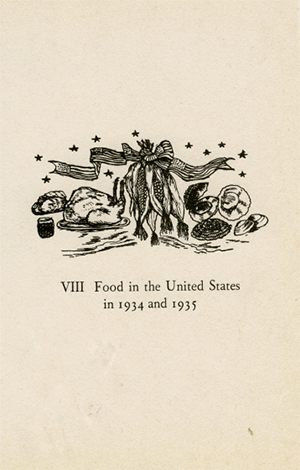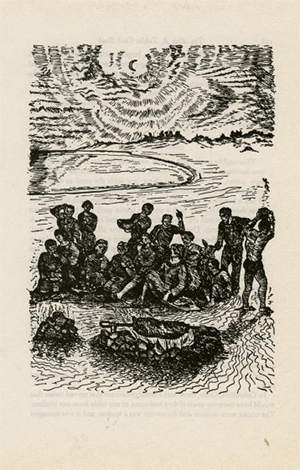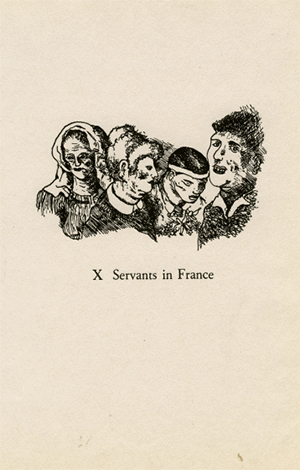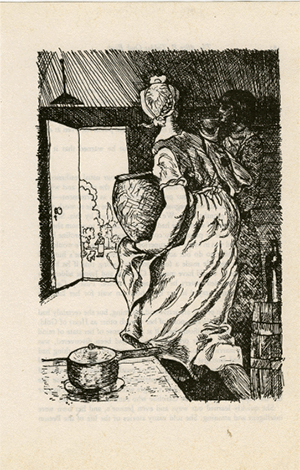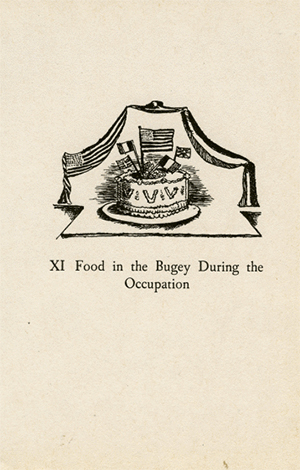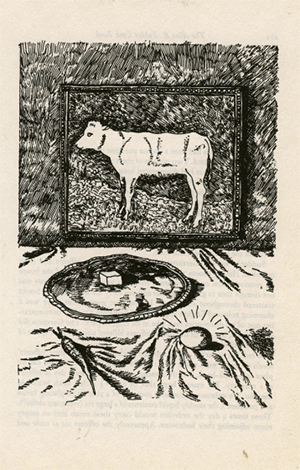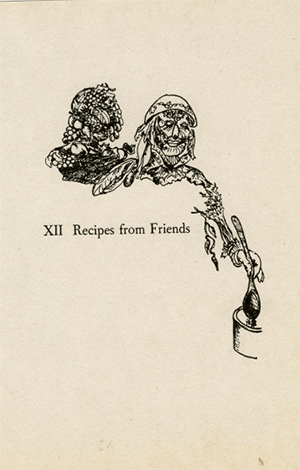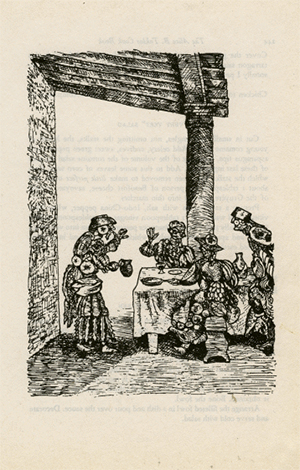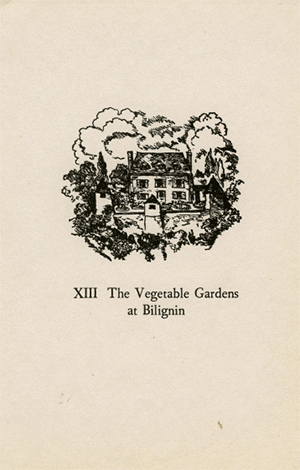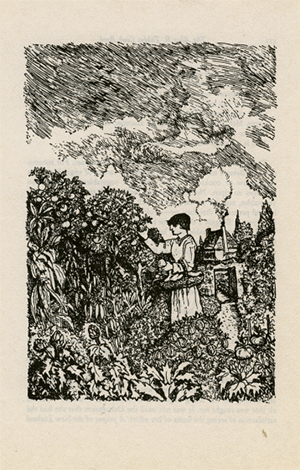9. Little-known French Dishes suitable for American and British Kitchens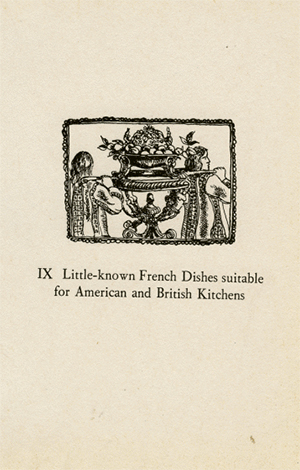
THESE dishes should add variety to American and British menus. In France they are no longer novelties nor creations, nor have they the distinction of being distinctive, which, as defined by a cousin of Gertrude Stein, is something that is done six weeks before all the world is doing it. On the contrary, they are most of them a slow evolution in a new direction, which is the way great art is created -- that is, everything about is ready for it, and one person having the vision does it, discarding what he finds unnecessary in the past. Even a way of cooking an egg can be arrived at in this way. Then that way becomes a classical way. It is a pleasure for us, perhaps for the egg.
It is, of course, understood that there are always those who rush in and irreverently add a dash or a pinch from a bottle, a tin or a package and feel that some needed flavour has been found. This, a matter too literally of taste, is not arguable. It is a pleasure to retire before such a fact.
For the preparation of these dishes, certain standard sauces and what the French call composed butters are necessary. Those used in these recipes follow these standards and conventions. To commence then at the beginning:
I.
COLD HORS D'OEUVRE
MUSSELS
After thoroughly scrubbing and rinsing, put 2 quarts mussels in a saucepan over highest heat with 3/4cup dry white wine, 1 tablespoon crushed shallot, 2 stalks of parsley, 1 twig of thyme, 1/4 laurel leaf, salt and pepper. Cover. About 2 minutes after it has come to a boil again look to see if the shells have opened. As soon as they have remove from flame, drain thoroughly, remove from shell, cool, chill. Just before serving mix with 3/4 cup Tartar sauce. Serve very cold. [1]
EGG PLANT A LA PROVENCALE
Wipe but do not peel 6 aubergines or egg plants, cut in slices of 1-1/2 inches, salt and pepper; put them in saucepan over medium heat in which 6 tablespoons olive oil are bubbling. Brown lightly on all sides, remove from flame, drain the aubergines. In the oil in which they have been cooked; put 3 blanched and skinned tomatoes that have been coarsely chopped. Add salt and pepper, 1 clove of crushed garlic and 2 diced anchovies. Cook over low heat until tomatoes are cooked. Remove from flame and add 1 tablespoon chopped basil. Place 1 teaspoon of this sauce on each slice of egg plant. On the sauce place a thin slice of lemon, on the lemon place a rolled anchovy, and in the anchovy stand 1 black olive upright.
SMALL FISH IN THE ORIENTAL MANNER
For 4 fish -- any small fish but preferably red mullets weighing 1/2 lb. each -- clean, dry and remove scales if necessary. Place in hot olive oil in a frying pan over great heat. Fry on both sides for 3 minutes. Remove from heat. Put in well-oiled fireproof dish and cover with 8 tablespoons puree of tomato that has been previously cooked for 10 minutes over low heat with 1/3 cup white wine, 1/4 teaspoon powdered saffron, 1/4 teaspoon powdered thyme, 1/4 teaspoon powdered laurel and 1/8 teaspoon powdered or ground coriander seed, 1 clove of crushed garlic, 1 teaspoon chopped parsley and salt and pepper. At the last moment add 4 tablespoons olive oil but without allowing it to boil. Cover and cook in preheated 400° oven for 8 minutes. Serve chilled.
STUFFED CUCUMBERS
Cut unpeeled cucumbers in half lengthwise. Boil for 2 minutes. Remove from heat. Put under cold-water tap, drain and dry thoroughly. When cold, with a sharp knife hollow out within 1/4 inch of the skin and fill with previously cooked, chilled and diced string beans and green peas. Chill thoroughly and cover with a green mayonnaise. Sprinkle with minutely cut chives.
GREEN MAYONNAISE
Put the yolk of 1 egg in a bowl with1/2 teaspoon salt and 1/4 teaspoon pepper. Stir well. Add drop by drop 2 tablespoons olive oil, constantly stirring. When it commences to stiffen add a few drops lemon juice and pour the oil in more quickly. It will require i cup of oil and the juice of 1/2 lemon. This mayonnaise must be particularly firm. Then gradually add the following puree:
Take equal parts of leaves of cress, spinach, chervil and tarragon, boil them in unsalted water for 2 minutes, drain and put under coldwater tap and press out the water. Pound in a mortar until they are reduced to a pulp that can be strained through a fine muslin. They should make 1/4 cup. Add to the mayonnaise, to which the greens will give not only a colour but a flavour.
FROGS' LEGS A LA PARISIENNE
In a saucepan over medium heat place the frogs' legs covered with dry white wine, salt and pepper, the juice of 1 lemon (for 50 frogs' legs). Poach for 10 minutes. Remove from heat and drain. In a bowl or dish place an equal volume of diced potatoes salted and peppered. Mix with mayonnaise (1/4 cup mayonnaise for 2 cups potatoes). Place the frogs' legs on the potato salad. Cover with mayonnaise.
CAULIFLOWER WITH MUSTARD CREAM SAUCE
Boil the flowerets of cauliflower in salted water for 10 minutes. Drain, cool and chill. Before serving, pour over them this sauce.
In a saucepan melt 1 tablespoon butter. Add 1 tablespoon flour and 1 tablespoon mustard. Mix thoroughly, add 2/3 cup boiling water. Mix with a whisk. Add 2 yolks of eggs mixed with 1 tablespoon whipped cream. Beat before pouring over flowerets and serve at once.
II
HOT HORS D'OEUVRE
POACHED EGGS BABOUCHE
For four, cut 2 large tomatoes in half, remove seeds and juice and grill. Place 1 tablespoon boiled rice in each half tomato, on which place a poached egg. Cover with 2 cups cream sauce, in which 1 teaspoon curry has been mixed and the sauce brought to a boil.
FRIED CREAM WITH CHEESE
Stir 2 whole eggs and 3 yolks, add gradually 1 cup and 2 tablespoons flour, stir carefully. The mixture should be perfectly smooth. Add 1/4 teaspoon salt, a pinch of pepper and nutmeg. Add 1 quart hot milk. Place over low heat and stir until the mixture is very thick, but do not allow to boil. Remove from heat and add 1 cup grated Swiss or Parmesan cheese. Spread on buttered marble, or on a large dish. The mixture should be about 1 inch thick. See that the edges are even. When cold, cut into squares. Dip into beaten egg, then into dried fine breadcrumbs. At the last moment, before serving, fry in deep oil.
OYSTERS SAUCE MORNAY
Poach oysters to heat, drain thoroughly and replace in shells. Sauce Mornay is a cream sauce with cheese in this proportion: If the oysters are large, 5 dozen will require 2 cups thick cream sauce to which has been added while still over low flame 2 tablespoons grated Swiss cheese and 2 tablespoons grated Parmesan cheese. Add in small pieces 4 tablespoons butter. Do not allow to boil. Remove from heat, completely cover the oysters. Sprinkle with a little grated cheese and place in 450 ͦ oven for 4 or 5 minutes. Serve at once.
OMELETTE PALERMITAINE
Mix 8 whole eggs with 4 tablespoons diced truffles, 3 tablespoons grated Parmesan cheese and 2 tablespoons lightly browned butter. With a fork stir until the yolks and whites are thoroughly mixed. In a very hot frying pan melt 3 tablespoons butter, allowing it to become very slightly browned. Pour the eggs into the frying pan. In l/2 minute bring the edges to the centre with a fork so that the eggs that are liquid may be cooked. If necessary tip the frying pan. In 2 minutes more the omelette will be done. Place 3 tablespoons of hot puree of tomatoes, to which has been added 2 tablespoons butter, on one side of the omelette. Fold the other side of the omelette over across the centre, and place on a hot serving plate. Surround with a thick tomato sauce.
FRIED OYSTERS
Poach the oysters for 1 minute in their own water. Remove from heat, drain and dry thoroughly. Sprinkle generously with olive oil, salt and pepper. Marinate for 1 hour. Cover each oyster with salted frying batter. Fry in deep fat, remove as soon as brown. Place on hot serving dish in a mound, and surround with very thin slices of lemon. In the centre of the mound place a quantity of slightly fried parsley.
SOUP
MIMOSA SOUP
Boil in salted water 1 cup string beans. When tender, depending upon size and freshness, remove from heat, drain and cut into cubes. Mash through a very coarse sieve the yolks of 4 hard-boiled eggs. Just before serving, bring to a boil 1 quart bouillon. Add diced string beans and the yolks of eggs. Bring to a boil again, remove at once and serve.
CREAM OF GREEN-PEA SOUP
Put % cups green peas in 6 cups boiling water in a saucepan over medium heat. Add 1 medium-sized onion, salt, pepper and 1 stalk of parsley. Boil uncovered until peas are tender -- about 25 minutes, depending on age and freshness. Prepare small croutons. Chop fine 1 tablespoon chervil. Mix 3 yolks of eggs with 6 tablespoons cream, add chervil. Before serving, remove onion and parsley from water in which peas have boiled. Add, at once, 1/2 cup butter cut in small pieces, do not stir but tip the saucepan in all directions. Pour over cream and eggs. Add croutons and serve.
CONSOMME WITH PARMESAN CHEESE CROUTONS
Mix 4 tablespoons grated Parmesan cheese with 1 tablespoon flour. Separate the yolks from the whites of 2 eggs. Beat the whites of the eggs, fold in the yolks, the grated cheese and flour, and salt and pepper. Spread this mixture on slightly buttered bread to a thickness of 1/3 inch and cook in medium oven for 20 minutes. While still hot cut into squares, rounds or ovals, and serve at the same time as 6 cups hot bouillon.
ONION SOUP
Brown 4 thinly sliced onions in 1 tablespoons butter in a saucepan over low heat stirring with a wooden spoon. In 20 minutes, sprinkle 1 teaspoon sugar over the onions. Add 6 cups boiling water, salt and pepper. Boil, covered, for 10 minutes. In a fireproof dish or casserole place 1/2 lb. bread cut in slices of 1/3-inch thickness. Cover each piece of bread with very thin slices of Swiss cheese. It will take a little more than 1/4 lb. cheese. Place them in the soup dish and pour over them the contents of the saucepan. The slices of bread will rise to the surface. Sprinkle on the top 4 tablespoons melted butter. Put the casserole in 375ͦ preheated oven for 10 minutes. Serve very hot.
FISH
MEURETTE
This is to Burgundy what the Bouillabaisse is to Marseilles. The fish are mixed river fish and should be small -- trout, perch, eel, pike and carp are most suitable. Use all five of them if possible. Clean and remove scales and fins, and wash 3 lbs. fish. If any of them are too large for one serving, cut in slices. Place in a saucepan over low heat 1 bottle red wine most nearly resembling Burgundy wine, with 1 large onion, 3 medium-sized carrots, the white ends of 2 leeks, 3 cloves of garlic, salt and pepper, a very small piece of nutmeg or a pinch of powdered nutmeg, a twig of thyme, a laurel leaf and 1 clove. Simmer for 1/4 hour. Strain this over the fish that have been placed in fireproof casserole. Add 1/4 cup brandy, cover and cook for 1/2 hour. Add 5 tablespoons butter cut in small pieces. Do not stir but tip casserole in all directions. Do not allow to boil. At the bottom of the serving dish place 8 pieces of bread toasted, and rubbed with garlic. Cover with the fish and pour the bouillon over it.
BAKED SHAD
Remove scales and fins of a 3 lb. shad. Wash thoroughly but do not allow to remain in water. Drain and dry. Cut in slices. In a generously buttered fireproof dish, place a thin sprinkling of 4 finely chopped shallots, 1/4 lb. finely chopped mushrooms and 1 tablespoon finely chopped parsley. Place the sliced fish on this, reconstructing the fish, head at one end, tail at the other. Add 1 cup dry white wine. Sprinkle 2 tablespoons melted butter on the fish. Cook in preheated 370° oven, baste frequently. After 20 minutes add 1/2 cup cream and cook for 10 minutes longer, having increased heat to 425°.
FILLETS OF SOLE PERINETTE
Salt and pepper 4 large fillets of sole. Prepare 2 cups mashed potatoes thoroughly mixed with 2 tablespoons cream, 1 egg, salt and pepper. Mash through fine sieve 2 yolks hard-boiled eggs. Chop very fin 1/4 cup truffles, mix yolks of eggs and truffles with potatoes. Spread this mixture on two of the fillets, cover each with another fillet, press them together. Cover them with a beaten egg mixed with 1 tablespoon olive oil and I tablespoon water. Cover with grated breadcrumbs. Melt in frying pan over medium heat 1/2 cup butter. Brown the fillets on both sides in this, reducing the heat so that the fillets will be cooked through. In a preheated serving dish spread 2 cups mashed potatoes, to which has been added 4 tablespoons browned butter. Place the fillets on the potatoes, and on the fillets place thin slices of truffles alternating with thin slices of lemon.
FRESH COD MONT-BRY
Have 3 lbs. fresh cod cut in thin slices. Heat 3/4 cup olive oil in frying pan over medium heat. Place the slices of fish which have been rubbed with salt and curry powder in the hot oil. Reduce heat and brown fish on both sides. Place them on serving dish on which has been spread a tomato and egg plant puree which has been prepared by cooking in a covered saucepan 6 peeled and chopped tomatoes and 4 peeled and chopped egg plants in 3 tablespoons olive oil with 4 cups dry white wine for 20 minutes. Salt and pepper, and strain. On each slice of fish place a thin slice of lemon and on the lemon place a tablespoon of diced pimiento heated in olive oil. Serve with
CURRY SAUCE
Chop 1 large onion and cook it in covered saucepan over low heat in 3 tablespoons olive oil for 20 minutes. Add 1 cup Bechamel sauce. Strain and replace over low heat. Add a pinch of saffron and 2 tablespoons curry powder, salt and pepper. Bring to a boil and serve in sauce boat at the same time as the fish. [2]
DEVILLED SMELTS
Clean, remove fins, wash and dry 6 smelts. In a bowl mix 1-1/2 tablespoons powdered mustard, 1-1/2 tablespoons French mustard, 3 tablespoons olive oil, 3 yolks of eggs, 1/2 teaspoon salt, 1 tablespoon anchovy paste and 1/4 teaspoon cayenne pepper. Mix thoroughly and spread on both sides of each fish. Pour melted butter over the fish and cover them with fine cracker crumbs. Grill over low heat. Serve with
DEVIL SAUCE
Put 1/4 cup dry white wine, 1 tablespoon vinegar, 1 tablespoon chopped shallots and 1/4 teaspoon pepper in a small saucepan over low flame. Simmer, stirring constantly with wooden spoon until reduced to half its volume. Add 1 cup tomato juice and 1 cup white wine. Bring to a boil, simmer and add 1-1/4 tablespoons flour thoroughly mixed with 1-1/4 tablespoons butter. Stir and watch carefully. The sauce should be perfectly smooth. Mix 1 tablespoon dry mustard, 1 tablespoon French mustard and 1/2 tablespoon anchovy paste, 1/4 teaspoon cayenne pepper, 1/4 teaspoon powdered saffron. Stir carefully, and simmer for 10 minutes. Remove from flame, strain into sauce boat and serve at the same time as the fish.
STEWED MACKEREL WITH PAPRIKA
If the mackerel are small take 4; if large, 4 slices. Clean, remove fins, wash and dry. In a stew pan melt 6 tablespoons butter over low heat, add 4 medium-sized onions cut in fine slices. Cover and simmer, shaking the pan from time to time, for about 20 minutes or until the onions are transparent. Then add I teaspoon paprika, salt and pepper. Place the fish on the onions with salt and pepper. Add 1 cup hot water. Cover and slightly increase heat. Cook for 20 minutes. Add I cup thinly sliced mushrooms. Cover and continue to cook for 8 minutes more. With a perforated spoon remove fish to hot serving dish. Add to saucepan a sauce prepared in advance of 2. tablespoons butter mixed with 1-1/2 tablespoons flour. Place over low heat, gradually add very hot water, stir and cook for 5 minutes. Add salt, pepper and 1/2 teaspoon paprika. Cook for 5 minutes more. Then add 3/4 cup heavy cream. Add to contents of stew pan. Heat thoroughly but do not boil. Pour over fish and serve.
SALT CODFISH A LA MONEGASQUE
Soak overnight 6 fillets salt codfish. In the morning put under cold-water tap. Drain, place in a bowl, cover with milk and soak for 2 hours. Then poach in water until tender. Drain, dry thoroughly, and cook over low flame in 1/2 cup olive oil in covered frying pan for 20 minutes. Shake the pan frequently and turn the fillets once. Place them on heated serving dish surrounded by small pieces of bread 1-inch thick lightly browned in oil. Serve with 1-1/2 cups thick tomato sauce in which 1/2 cup capers have been cooked.
RAY WITH BLACK BUTTER
The thorn-back ray is the best variety. Nothing is removed from the large ones, as they are sold ready to cook. The small ones require to be scraped, the gall, head and tail removed carefully, the fish cleaned and washed. Put 3 lbs. ray in a saucepan with cold water to cover, with 1 tablespoon salt and 2 tablespoons vinegar. Bring to a boil over medium heat. When the water boils, reduce to the least possible heat and allow 1/2 hour for a large piece of ray and 20 minutes for small ones. Remove from water, drain thoroughly. Place wrapped in a cloth in tepid oven with door closed while the black butter is being prepared.
Place 1 cup butter in frying pan over medium heat with 1 teaspoon salt, 1/4 teaspoon pepper and 1 cup unchopped parsley. Add juice of I lemon. Pour butter and parsley at once over fish, which has been placed on serving dish, and serve.
POULTRY
CHICKEN IN HALF MOURNING
Cook 4 truffles, in Madeira to cover, over lowest flame in covered saucepan for 20 minutes. Remove from flame and allow to cool in wine. Place a fine chicken in a cocotte with a tight-fitting cover. Pour over it to half its height hot veal bouillon with 1 teaspoon salt, 1/2 teaspoon pepper, a bouquet of parsley and thyme and 1/2 laurel leaf. Bring to a boil over medium heat, then gradually reduce to lowest flame. One hour will cook the chicken. For the sauce, heat in saucepan over medium heat 1/2 cup butter, add 3 tablespoons flour, gradually add 3 cups veal bouillon and 1/4 cup chopped mushrooms, stirring with a wooden spoon. As soon as it comes to a boil reduce heat and simmer uncovered for 1/2 hour. Stir to prevent scorching or burning. Remove from heat, strain, skim, add 1/2 cup heavy cream and 1-1/2 finely chopped truffles. Cut chicken in serving pieces, and place on heated serving dish. Heat the sauce but do not allow to boil. Pour over chicken, and on each piece place a slice of truffle and serve.
BRAISED CHICKEN STUFFED WITH NOODLES
Poach for 6 minutes in boiling salted water 1-1/2 cups noodles cut in narrow strips. Remove from flame, drain, place under cold-water tap and drain again. Place in a bowl, and, mixing lightly with a fork, add to them 1/2 cup grated Parmesan, 1/2 cup grated Swiss cheese and 3/4 cup heavy cream. Add 3/4 cup small mushroom caps, salt and pepper. Mix well. Stuff the chicken with this dressing. Skewer or sew the opening together. Skewer legs and wings to keep in place during cooking. Put 4 tablespoons butter in enamel-lined pot over medium flame. Brown the chicken lightly in the butter. Add 1 cup hot chicken bouillon. Cover the pot and lower the flame. Simmer for 1 hour, basting, from time to time. Prepare a Sauce Mornay, which is a Bechamel to which grated cheese has been added. For this chicken the proportions are 2-1/2 tablespoons butter, 2 tablespoons flour, 2 cups milk, 1/4 teaspoon salt. Simmer for 1/2 hour. Stir with a wooden spoon frequently to prevent burning. Remove from heat, add 1/2 cup grated Parmesan cheese. Place the chicken in a fireproof serving dish. Cover with the Sauce Mornay and place for 10 minutes in 450 ͦ preheated oven to glaze.
COCK IN WINE
Cut a young cock or a young chicken in serving pieces. In an enamellined pot melt 3 tablespoons butter, add 3/4 cup diced side fat of pork, 6 small onions, 4 shallots and 1 medium-sized carrot cut in thin slices. Brown these in butter. Remove and place pieces of chicken in pot and brown over high heat. Add salt, pepper and 2 cloves of crushed garlic. Remove the browned pork fat, onions, shallots and carrot. Heat 3 tablespoons brandy, light and pour into pot. Sprinkle 3/4 tablespoon flour into the pot. Stir with a wooden spoon for 2 or 3 minutes, then add 1 cup fresh mushrooms and 1 cup hot good dry white wine. Increase heat, add pork fat and vegetables. Cook uncovered for 1/4 hour. Serve very hot.
A FINE FAT PULLET
A fine fat pullet is cleaned, the breast bone is removed with a small sharp knife and the bird is well skewered. Place 3/4 cup lard, 3/4 cup butter and 4 tablespoons olive oil in a casserole. Place the chicken in the casserole over medium heat. When the fats commence to boil reduce heat -- the chicken should not brown. Add 2 tablespoons finely chopped shallots, 6 tablespoons finely chopped mushrooms, 2 tablespoons finely chopped parsley, 1/2 teaspoon salt, 1/4 teaspoon pepper. Cook for 10 minutes. Remove chicken and cover with contents of casserole. As the chicken cools, again cover with the fats and chopped vegetables. It may be necessary to do this several times. When the chicken is cold, wrap it in a thin slice of fat back of pork. Take six sheets of white paper large enough to cover the chicken completely and oil each sheet generously. Place the chicken on the first sheet and bring the end of the sheet to the middle of the breast of chicken. Continue with the other sheets. Tie the sheets so that the chicken is hermetically closed. Return chicken to casserole and cook for 1 hour in preheated 350 ͦ oven. To serve, cut the string of the sheets. If the two outside sheets are too dark from the oven heat, remove them but do not disturb the others. Send to the table wrapped in the remaining sheets.
GODMOTHER'S CHICKEN
In the cavity of a fine chicken put 1 cup chicken bouillon, 1/2 cup butter and a large bunch of tarragon which have been well mixed together, sew up the cavity and skewer the legs and wings. Place in a pot over medium heat, with 2 cups chicken bouillon, salt and pepper. When it comes to a boil, cover hermetically, reduce to lowest flame and simmer for 3/4 hour. Remove the chicken broth and the juice from the cavity of the chicken into the pot. Put the chicken aside and reduce the contents of the pot by half. Remove from flame and add 1/2 cup soft butter. Stir until melted, add salt, pepper, a pinch of powdered nutmeg and a pinch of cayenne pepper. Return to low heat. When very hot remove from heat and add the juice of 1/2 lemon and 2 tablespoons Madeira. Cover the chicken with the sauce.
CHICKEN MONTSOURIS
Cut a chicken down the back and flatten it with a mallet. Put it in a casserole with pepper, salt and 1/4 lb. butter over high flame. As soon as the butter bubbles put in preheated 400 ͦ oven. Baste frequently. After 35 minutes remove from oven. Put chicken on serving dish. Put the casserole over medium flame and add 2 finely chopped shallots. Heat 1/3 cup brandy, light it and pour into casserole. Add 2 tablespoons heavy cream, 1 teaspoon finely chopped tarragon. Stir with wooden spoon. Before it boils, add 5 tablespoons butter cut in small pieces. Tip casserole in all directions until butter is melted. Pour over chicken and serve.
MINUTE SQUABS (OR YOUNG PIGEONS)
Cut the squabs in half. Flatten them gently with a mallet. Paint with melted butter. In a frying pan over hot flame put for 2 squabs 1/2 cup butter. Keep turning the pieces so that they do not burn. They will be cooked in 12 minutes. When they are half cooked add 1 tablespoon onion juice. Place the squabs on preheated serving dish. Add to contents of pan 1 tablespoon cognac. Scrape pan to detach glaze. Stir in 1/2 cup hot bouillon. Add 1 teaspoon chopped parsley and pour over squabs.
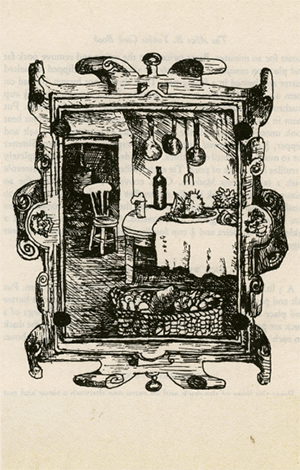
ROAST SQUAB ON CANAPES
Place in the cavity salt and pepper. Cover squabs with thin slices of back fat of pork and tie securely. Put them in preheated 400° oven. Roast for 20 minutes. Baste twice. Cut the string and remove pork fat and place on canapes. The canapes are slices of bread dipped in melted butter and heated in a frying pan. They should not brown. Spread on them a puree of mushrooms and truffles. For 4 canapes, chop 1/2 cup mushrooms, pound them with a potato masher through a sieve. Put them in a saucepan with 2 tablespoons butter and over medium heat cook uncovered until all the moisture has evaporated. Add salt and pepper, 1/4 cup Bechamel sauce and 1 tablespoon heavy cream. Simmer for 10 minutes or until quite thick. Put aside. Wrap to cover completely 4 truffles in fat back of pork. Tie each truffle securely. Place in casserole with 2 tablespoons Madeira. Cook covered over low flame for 20 minutes. Remove pork fat. Pound truffles through a sieve and add to mushroom puree. Add the juice in which the truffles have cooked to the pan in which the pigeons have roasted. Over medium flame add 2 tablespoons Madeira and 1/2 cup bouillon. Bring to a boil and pour over pigeons.
DUCK WITH BORDELAISE SAUCE
A 3 lb. duck will take about an hour in a preheated 400° oven. Put salt and pepper in the cavity. Paint the bird with 4 tablespoons butter and place in oven. Commence to baste after 1/4 hour. As the legs of a duck are proportionately heavier than those of a chicken, turn the duck on each of its sides for 10 minutes after it has been in the oven 1/2 hour.
BORDELAISE SAUCE
Press the liver of the duck and an extra one through a sieve and put aside. Put 2 finely chopped shallots with 2 tablespoons butter in saucepan over low heat. When all the moisture has evaporated, let them cook a few minutes longer to form a glaze. Add 1/2 cup bouillon in which 1 tablespoon tomato puree has been dissolved and to which 1 tablespoon flour and 1 tablespoon butter has been added. Add 4 tablespoons lighted brandy. Bring to a slow boil, add salt, pepper and a pinch of cayenne. Simmer for 10 minutes. Add 1/2 cup bouillon. Bring to a boil. Slowly pour half the contents of the saucepan over the two strained livers. Pour into the saucepan and replace over low heat, stirring constantly, but do not allow to boil. Add 4 tablespoons butter. Tip saucepan in all directions, do not stir. When butter is melted, pour into preheated sauce boat and serve at the same time as the duck.
YOUNG TURKEY WITH TRUFFLES
For a turkey weighing 6 to 7 lbs. you will require 3 lbs. of the fat that surrounds pork kidneys. Melt it and strain. Pour 4 cups of whole truffles into a quarter of the melted pork fat. The truffles should be cut in half or in quarters, according to size. Poach for 1/4 hour, mix with the rest of the fat and cool. When cool, fill the cavity of the turkey into which salt, pepper and a little nutmeg have been rubbed with the cold fat and truffles. Sew the cavity together, skewer wings and legs. Put aside in a cool spot -- but not in the refrigerator -- for two days in winter and one day in summer. When ready to roast, wrap the turkey in buttered paper. Roast in 400° preheated oven, allowing 10 minutes to the pound. Half an hour before it is ready to be taken from the oven, remove paper. Baste three times before removing from the oven. Place on serving dish. Skim the fat from the juice, add 3 cups of the bouillon of the giblets, neck and first joints of wings (that have been poached for 2 hours in water to cover, and then strained together with 1 bay leaf, a sprig of thyme, parsley and salt and pepper). Mix well to detach the glaze from the pan. Serve in sauce boat.
MEATS
SPRING NAVARIN
Ask the butcher to cut in square pieces -- two to a serving -- 2 lbs. shoulder of mutton. In an iron or enamelled pot melt 2 tablespoons butter over high flame. When the butter is very hot, place the pieces of meat in it. Stir with a wooden spoon until all sides are lightly browned. Add salt, pepper and 2 tablespoons flour after the fat has been skimmed off. Stir for 10 minutes. Cover with hot water stirring constantly. The sauce should be perfectly smooth. Add a bouquet of thyme, parsley and a laurel leaf, a pinch of powdered nutmeg, a large onion with 1 clove stuck in it and a clove of crushed garlic. Add 1 lb. tomatoes, blanched, peeled, seeds removed and cut in small pieces. Bring to a boil, cover pot, and reduce heat. Wash 1dozen new potatoes, dry and rub off the skins, scrape 1 dozen young carrots, wash and dry them and remove outer skin of 1 dozen spring onions, peel 1 cup young turnips and cut in quarters. Heat 4 tablespoons butter in a saucepan over medium heat. When hot, put in the turnips and sprinkle over them 1 teaspoon sugar. Brown them on all sides, stirring constantly. Then strain and put aside. Shell 1 cup green peas. Snap off the ends of 1 cup of very young string beans. After 1 hour's cooking remove bouquet and onion from pot. If there is any fat on the sauce, skim. Bring to a good boil and add the potatoes, carrots, turnips and onions. Cover and reduce to medium heat. Boil for 10 minutes in salted water, in separate saucepan, the green peas and beans. After the first vegetables have cooked in the pot for! hour, add peas and beans. Cook for 1/2 hour longer, skim the sauce again, and serve very hot in preheated hollow dish.
BOEUF BOURGUIGNON (2)
Ask the butcher to cut 2 lbs. upper shoulder of beef in square pieces, two pieces for one serving. Marinate in 6 tablespoons brandy for 6 hours, turning the meat frequently. In an iron pot over high flame put 4 tablespoons butter. While it is very hot place the meat in it in a single layer -- no piece should cover another. Brown them on all sides, remove and put aside. Put into the pot 1 cup diced side fat of pork, brown and remove. Put into pot 12 small onions, brown and remove. From the pot remove about two-thirds of the fat. Put into the pot 1 tablespoon and 1 teaspoon flour. Stir with wooden spoon for 10 minutes and add the meat. Pour over it 3 cups hot red Burgundy wine or a wine that resembles it as nearly as possible and 1 cup hot water. Add a little salt, pepper, the diced pork fat, a bouquet of thyme, parsley and laurel leaf, a pinch of ground nutmeg and J crushed clove of garlic. Cover and when the contents of pot commence to boil reduce to medium heat. Cook for 2-1/2 to 3 hours. Add the onions and cook for 1/2hour longer. Remove bouquet, if necessary skim, place on hollow serving dish and sprinkle over the meat 1 tablespoon finely chopped parsley.
It very much adds to the flavour of the dish to add at the last moment 2 cups small fresh mushrooms that have been cooked in a saucepan over low flame in 4 tablespoons butter for 10 minutes.
VEAL MARENGO
Ask the butcher to cut in pieces suitable for serving 2 lbs. shoulder of veal and remove bones. Put in iron pot over high flame 1/2 cup olive oil. When it commences to smoke put in the pieces of meat side by side. Brown on all sides and remove. Dice 1 cup mushrooms, place in pot, brown and remove them. Put 12 small onions in the pot, brown them and remove. Remove two-thirds of the oil from the pot and put in pieces of meat. With a wooden spoon mix 1 tablespoon and 1 teaspoon flour with the fat in the pot, brown for 2 or 3 minutes. Add 1-1/2 cups hot dry white wine and 1-1/2 cups hot water. Add 2 medium-sized tomatoes skinned, seeds removed and cut in cubes of about 1 inch, a bouquet of thyme, parsley and 1 laurel leaf, 2 crushed shallots and 1 clove of garlic, salt and pepper. Add to the pot the onions and mushrooms. Reduce heat, cover the pot, cook for I hour. Skim the oil, remove the bouquet, cover pot and cook for 10 minutes longer. Pour into preheated dish and surround with triangular pieces of bread, about 1/2 inch thick, that have been very lightly fried in olive oil.
FILLET OF BEEF ADRIENNE
Prepare a marinade with I bottle dry white wine -- the better the wine the better the sauce -- 1/2 cup olive oil, a bouquet of thyme, parsley and 1 laurel leaf, 2 sliced medium-sized carrots, I sliced medium-sized onion, pepper and salt. In this, place a 3 lb. fillet of beef. Cover and put aside, but not in the refrigerator, for 48 hours. Turn the meat in the marinade twice a day. At the beginning of the third day remove meat from marinade and dry thoroughly. Wrap it in a thin slice of back fat of pork and tie this securely round the fillet. Place in a preheated oven 350°. Put the marinade, including the vegetables, in a saucepan over low flame. Turn the fillet after 1/4 hour. After 1/2 hour commence to baste the roast with 4 tablespoons of the hot marinade. Baste every 10 minutes with marinade. The roast will be cooked in an hour. Remove from oven, remove pork fat, and place on serving dish. When the juice in pan boils again, add I tablespoon flour and 1 tablespoon butter previously well mixed in bowl, hot water, and then 3 teaspoons currant jelly. Mix thoroughly, allow to boil. Add 2 tablespoons brandy. Strain sauce into sauce boat. Salt each slice of fillet as served.
DAUBE OF SLICED-BEEF NICOLETTE
A daube is an earthenware recipient high for its circumference. The meat that is cooked in such a recipient is always mentioned as being cooked in daube. Cut 3 lbs. fillet in thin slices, flatten with mallet. Cover each fillet with a thin slice of side fat of pork of the same size. Chop 3 large onions, 1/2 cup parsley, 2 cloves of garlic, 3 shallots, 1/2 cup chervil, and 4 truffles. Add 1/2 teaspoon powdered thyme, 1/2 teaspoon powdered laurel leaf, 1/2 teaspoon salt and 1/4 teaspoon pepper, 1/4 teaspoon cinnamon and 1/4 teaspoon cloves. Mix thoroughly. Spread some of this mixture on the pork fat, cover with another piece of pork fat. Recommence with the next slice of fillet-pork-fat mixture. Place these prepared slices one on top of the other and tie securely. In the daube or in a fireproof earthenware casserole with a cover that closes hermetically put 1/4 cup butter. Place over medium heat, add 1 cup chopped fat back of pork, chopped coarsely, the fillet, a calf's foot, a bouquet of parsley, chervil, laurel leaf, twig of thyme, 1/2 teaspoon curry powder, 1/2 teaspoon salt, 1/4 teaspoon pepper and 4 tablespoons puree of tomatoes. Cover with 1 bottle Marsala and 2 cups hot water. Cover and bring to a boil. Reduce heat and simmer for 4 hours. Then remove daube from heat. Remove meat from juice, place in bowl and remove strings when cool enough to do so. The slices should remain in place. Strain juice over slices of beef, which it should cover. Set aside in a cool place for 24 hours. Remove from bowl to serving dish.
ROSETTES OF BEEF
For six servings take 12 slices from the small end of a fillet of beef. Melt 1/2 cup butter in a fireproof earthenware casserole with a cover that closes hermetically or in an enamel-lined pot, over medium heat, and add the fillet. Heat 4 tablespoons brandy, light and pour over the fillet. Add 1 large onion, chopped fine. Cover with heavy cream and 1/2 cup strong beef bouillon, 1/2 teaspoon salt and 1/4 teaspoon pepper. Cover and place in preheated 350 ͦ oven for 1-1/2 hours. Place in serving dish with sauce poured over it.
VEGETABLES
ENDIVES
Wipe 12 endives, remove outer leaves, cut both ends. In a casserole with a cover that closes hermetically place 1/2 cup butter. Heat over low flame. Add the endives, sprinkle 1/2 teaspoon salt and 1/4 teaspoon sugar over them and the juice of 1 lemon. Cover with a well-buttered piece of waxed paper. Reduce heat to smallest flame, cover and cook for 5 minutes. Raise to high flame and cook for 20 minutes longer. Shake the casserole from time to time but do not uncover until ready to serve.
BROWNED SPINACH DAISY
Wash in five waters 4 lbs. spinach. Drain and press to remove most of the water. Put by handfuls in a saucepan over highest heat. Turn with a wooden spoon so that each new handful is at the bottom of the saucepan. When the spinach has been thoroughly heated cover saucepan. Gradually reduce heat to low flame. Boil for 5 minutes, drain, place under cold-water tap until spinach is tepid. Place in a saucepan over low heat and stir with a wooden spoon until all the water has evaporated. Prepare a puree of mushrooms by pounding through a strainer 1 lb. fresh mushrooms. Place in a saucepan over low heat. With a spoon stir until all water has evaporated. Place 1-1/2cups thick Bechamel sauce in saucepan over medium heat. Add 1 cup heavy cream. Stir until thick. Add salt, pepper, a pinch of nutmeg, the mushrooms and 4 tablespoons butter. Mix well and remove from heat. In a well-buttered fireproof casserole place a layer of one-third of the spinach, then one-third of the puree of mushrooms -- three layers of each. Cover with 1-1/2 cups Bechamel sauce in which 1/2 cup grated Swiss cheese has been mixed. Sprinkle over this 3 tablespoons melted butter. Stand in a recipient of hot water and put in preheated 300° oven. The water should not boil. Bake for 1 hour.
CREAMED CUCUMBERS
Peel 12 cucumbers. Dice them in 1-inch cubes. Put them in 4 cups boiling salted water over medium heat. Cover the saucepan and boil from 5 to 10 minutes, until they are no longer hard. They should not be overcooked. Remove from heat, place them under cold-water tap until they are tepid. Drain and wipe dry. In a saucepan over a low heat put 1-1/2 cups cream sauce. When hot add cucumber. Gently stir so that the sauce does not scorch. When the cucumbers and sauce come to a boil add 4 tablespoons butter cut in small pieces. Reduce heat to low flame and dip saucepan in all directions until butter is melted. Place in preheated serving dish and serve at once.
POTATOES SMOTHERED IN BUTTER
Peel 2. lbs. medium-sized potatoes, cut in eight pieces. In a saucepan over medium heat put 3/4 cup butter. When the butter has melted, put the potatoes into the saucepan and cover. Stir with a wooden spoon from time to time. Reduce heat after 1/4 hour. If the butter is too reduced add more. (This will depend on the kind of potatoes used.) Increase heat to medium, then to high. The potatoes should be browned and crisp on the outside and soft on the inside. Salt (no pepper) and serve very hot.
THE REAL RIGHT WAY FOR FRENCH FRIED POTATOES
Peel the potatoes, cut them all of the same size and length. Put them in moderately hot oil, lard or very white beef fat -- there should be enough so that the potatoes are not crowded. When the potatoes come to the surface, remove them from the fat at once. Let the fat reheat quickly, increase to highest flame. The potatoes should not be out of the fat more than 2 minutes. Plunge them into the fat for the second time and remove at once. Sprinkle with salt and serve at once.
SALADS
SALAD BAGRATION
Six hearts of artichokes, in 1/3-inch slices, shredded raw celery root (celeriac). Put aside. Bring I quart salted water to a rolling boil. Drop into it 1/4 lb. macaroni broken into 3-inch lengths. As soon as the water recommences to boil, lower heat and cook gently for 15 minutes. Cut off heat, but allow macaroni to stand covered for 5 minutes. Then drain thoroughly, cool. Mix the vegetables and macaroni, salt and pepper, and 1-1/2 cups mayonnaise to which 3 tablespoons puree of tomatoes have been added. Place in a mound on serving dish, surround with alternating borders of chopped yolks of 4 hard-boiled eggs, 8 slices chopped smoked beef tongue and chopped hard-boiled whites of eggs. Sprinkle over mound and border 2 tablespoons finely chopped parsley.
SALAD CANCALAISE
For each serving take 1 leaf of lettuce; on this place 3 tablespoons diced potato mixed with I teaspoon mayonnaise. On this place 3 poached oysters drained and placed on linen cloth to dry, then mixed with oil, lemon juice and pepper. On the oysters place a thin slice of truffle. Place the lettuce leaves and their garnishings on a round dish in a circle with one in the centre.
SALAD NICOISE
Take equal parts of diced potatoes and diced string beans. Boil separately- -- he potatoes in covered cold salted water brought to the boil, the string beans in boiling salted water. Do not overcook. When cooked remove from water and drain thoroughly. When cold mix the two vegetables, add two parts oil to one part lemon juice, salt and pepper. Place in a mound in salad dish and decorate with anchovies, stoned black olives and capers. Surround with quarters of peeled tomatoes. Sprinkle generously with chopped basil.
SALAD PORT ROYAL
Take equal parts of boiled sliced potatoes, shredded peeled apples and cubed boiled string beans. When the potatoes and string beans are cold, mix with apples, salt, pepper and mayonnaise. Place in salad bowl, cover with small quantity of mayonnaise, decorate with cubed string beans. Surround with quartered heads of lettuce and quartered hardboiled eggs.
SALAD RAPHAEL
Shred lettuce and mix with mayonnaise made with 1 teaspoon paprika, instead of black pepper. Surround alternately with sliced cucumber, peeled tomatoes, cut in eight parts, and hearts of lettuce. Place between each of these vegetables 4 small finely sliced unpeeled radishes. Pour over the border a vinaigrette of two parts oil, one part lemon juice, salt, pepper and chopped chervil.
POTATO SALAD
In a large bowl place 1 tablespoon French mustard, 1/4 teaspoon pepper, 1 tablespoon chopped chervil, 1 tablespoon finely cut chives, 1 tablespoon finely chopped tarragon and 1 tablespoon chopped parsley. Remove the skin, head, tail and bones of 1 salt herring. Pound the flesh and mash through fine strainer, add to the contents of the bowl. Shred I tart apple and put in bowl. With 2 tablespoons olive oil amalgamate thoroughly, then slowly stir into it 1/2 cup strong beef bouillon. It should be perfectly smooth. Slowly add 1 cup dry white wine. Into a saucepan of cold water over highest flame put 2 lbs. unpeeled potatoes. Cover, and when the water comes to a boil regulate heat. Do not overcook. Remove from water, drain, peel and thinly slice while hot. Put into bowl and mix with the sauce. Keep the saucepan covered and remove one potato at a time. Be careful in mixing not to bruise the potatoes. When thoroughly mixed, put aside for at least 3 hours before serving.
SALAD MELI-MELO
Mix 10 oysters poached for 1 minute, 10 mussels, 1/2 cup shrimps, the meat of 1 medium-sized lobster, 3/4 cup very young diced string beans, 5 sliced hearts of artichoke, 10 green tips of asparagus, 1/4 cup diced beetroot, 1/2 cup celery cut in thin rings, salt and pepper. Mix lightly and pour over the mixture 1 cup olive oil and 1-1/2 cups dry champagne.
WINTER SALAD
Large sweet Spanish onions cut in thin rings with this sauce: 2 tablespoons French mustard, 1 teaspoon salt, 1/4 teaspoon pepper, 1 tablespoon paprika, 1 cup heavy cream. Mix well and pour over onions at the last moment.
SALAD LIVONIERE
A mixture of vegetables of the season in equal quantities. For four cups, add 1/2 teaspoon salt, 1/4 teaspoon pepper, 1 teaspoon French mustard, 3 tablespoons brandy, 3 tablespoons Madeira, 2 tablespoons oil and 1 tablespoon vinegar.
DESSERTS
COLD DESSERTS
BAVARIAN CREAM PERFECT LOVE
Mix 2 cups sugar and 8 yolks of eggs until lemon-coloured. Slowly add 2 cups hot milk in which 6 cloves have been heated. Put in saucepan over lowest heat. With a wooden spoon stir continuously in the same direction until the spoon remains thickly covered. Do not allow to boil. Remove from heat and pour over 1/2 tablespoon powdered gelatine that has been soaked for 5 minutes in 1/4 cup cold water. Stir in the same direction until the gelatine is completely dissolved, then strain and stir from time to time in the same direction until cool. When cold, mix with 3 cups whipped cream to which the grated zest of 2 lemons have been added. Pour into lightly oiled mould and place in refrigerator for 4 hours. Remove from mould to serving dish. The cream may be flavoured with fruit puree. Two and a half cups puree and I tablespoon lemon juice are mixed with 1/2 cup icing sugar.
A chocolate cream is made by melting 3 ozs. chocolate in the milk; a coffee cream, by substituting 2. cups strong coffee for the 2 cups milk. For the rest, proceed as above.
CHARLOTTE CREAM
Prepare half the quantity of the above recipe. Cut sponge fingers to fit a lightly oiled mould; for the bottom, cut to fit; for the sides, cut one end straight across, and even the tops after the lined mould has been filled with the cream. Any flavour may be used. When it is ready to be served,. decorate through a forcing tube with whipped cream and surround by whipped cream. If a fruit puree is used, decorate on top with whipped cream and surround by whole fruits -- the same kinds as used for the flavouring -- cooked in a heavy syrup and well drained. Or instead of a puree of fruit, the recipe for Cream Perfect Love may be used, omitting the lemon and clove flavouring, and adding 1-1/2 cups fresh fruit or berries macerated for several hours in best kirsch or curacao and well drained. A cream made with a puree of fruit may have added to it another fruit diced and macerated, for example a strawberry or raspberry puree with cubed peaches or apricots -- or vice versa -- the combinations are endless. [3]
CREME RENVERSEE A LA CEVENOLE
(Chestnut Custard)
Stir 2 whole eggs and 4 yolks with I cup sugar until it is pale lemon-coloured. Slowly add 2 cups hot milk. Strain through a sieve. Stir from time to time until cold, then mix with a puree of chestnuts made by shelling 25 chestnuts and boiling them gently for 7 or 8 minutes. Remove from heat, drain and replace in covered saucepan. Take out a few at a time and remove skins (they peel more easily when warm). Put the peeled chestnuts in a pan over medium heat with 2 cups milk, 1 tablespoon butter, a stick of vanilla cut in half and a pinch of salt. When it commences to boil, place the covered saucepan in a 275 ͦ preheated oven. It will take about 3/4 hour. If necessary add hot milk. When quite tender, mash while very hot through fine strainer. Replace over low heat and add 1/2 cup sugar. When sugar is dissolved remove from heat. When cold, mix with egg-milk mixture. Pour into buttered mould and place in a recipient containing hot water to within 1 inch of the top of the mould. Place mould in preheated 275 ͦ oven for about 3/4 hour. It is very important that the water in which the mould is standing does not boil. If water evaporates, add boiling water. Do not remove the cream from the mould until cold.
This dessert can be poured into a ring mould, and at the last moment whipped cream lightly sweetened is placed in the centre. One tablespoon icing sugar added to 1 cup cream and flavoured with 1 tablespoon kirsch to the cup. This custard, in double the quantity before adding the chestnuts, can be prepared by adding any desired flavouring; for example, moulded coffee custard is made by replacing 1 cup milk with 1 cup strong coffee, or chocolate custard by adding 2 ozs. melted chocolate to milk.
CREME CAREME
This is a dessert created by Careme, the great early-nineteenth-century cook who wrote several of the most important French cook-books.
Mix 8 yolks of eggs with 3/4 cup sugar and 1 tablespoon rice flour (or a little less than 1 tablespoon cornflour) until the mixture is pale yellow. Add very slowly 3 cups hot milk. Put in a saucepan over very low heat, stirring with a wooden spoon until the spoon is thickly coated. Remove from heat, stirring occasionally until cold. Put in the refrigerator (Careme says on ice and surrounded by ice). Remove from refrigerator from time to time to stir. Just before serving add 1/3 cup best Maraschino and 1-1/2 cups whipped cream. You will then have (these are Careme's words) a light velvety mellow cream.
APPLE MOUSSE
Peel 8 apples, remove cores, cut in eighths and put in saucepan over medium heat with 1 cup sugar, 1 cup water and the zest of a lemon. Stir from time to time, gradually lower heat. Cook until it has become quite thick. Before removing from heat add 1/2 oz. gelatine that has been dissolved in 1/4 cup water. Mix thoroughly, add the juice of 1 lemon. Strain, and with an electric beater or egg beater whip the apple sauce until it is very frothy. Put in refrigerator. Before it becomes too stiff, in about 1/2 hour, add 1-1/2 cups unsweetened whipped cream flavoured with a liqueur, Grand Marnier if convenient. Three tablespoons will be sufficient. Any liqueur is suitable, but it is preferable to use one with a fruit base rather than a herb. Serve chilled in bowl.
FRUIT MOUSSE
One lb. mixed fruits of the season -- bananas and fresh pineapples are always acceptable additions. Peel the fruits and remove stones, cut bananas in half their length and half their width, pineapple in thin slices -- do not dice -- and leave large fruits whole. Arrange in deep serving dish and place in refrigerator several hours before serving. At the last moment mix 8 yolks of eggs with 3/4 cup best kirsch and 1 cup sugar. Beat with an electric beater or egg beater until thickened and frothy. Pour over fruits and serve.
APPLES WITH RASPBERRY SYRUP
Peel, core and cut in quarters 1-1/2 lbs. apples. Put in saucepan over high heat with 1 cup sugar, 1/2 cup water and the zest of a lemon. Stir to prevent scorching. Boil for 20 to 25 minutes. Remove from heat and strain into lightly buttered mould, the bottom of which should have a piece of white paper to fit. When cool place in a refrigerator for several hours. Unmould when ready to serve and turn on to serving dish. Pour over it 2 cups strawberry or raspberry puree. If these fruits are not in season, heat 1-1/2 glasses jelly with 2 tablespoons water. Heat only sufficiently to liquefy the jelly, which should be chilled before using.
PEACHES GLACEES
Put 6 fine peaches in hot water only long enough to peel. Prepare a syrup of 1 cup sugar and 3/4 cup water. Poach the peaches covered in the syrup over low flame for 4 minutes. Remove peaches and drain. When the syrup is quite thick, after about 3 minutes' further cooking pour over peaches. See that it adheres. When cold place peaches on serving dish in refrigerator for at least 2 hours. Prepare a puree of 1 lb. fresh strawberries, 1/4 cup icing sugar, add 2 tablespoons best brandy and I cup whipped cream. Put in refrigerator for at least 2 hours. Before serving pour puree over peaches.
HOT DESSERTS
APPLE FRITTERS
Remove core and peel 6 apples, cut in 1/3-inch slices. Put in bowl and macerate for 1/2 hour in juice of 1 lemon, 2 tablespoons sugar and 3 tablespoons brandy. Turn several times in order to moisten and sweeten all the slices. The batter is prepared by sifting 1 cup flour into a bowl and mixing gradually with 1 egg, 1 cup light beer, 3 tablespoons brandy and 3 tablespoons olive oil. Mix thoroughly, the batter should be perfectly smooth. It is best, if convenient, to prepare the batter the night before using. It must be made at least several hours before being used. The apples are dipped in batter and at once fried in deep fat. When browned, remove with perforated spoon, cover generously with sugar. While still hot, place in hot oven to glaze.
All fruits are prepared in this way for fritters.
OMELETTE A LA BOURBONNAISE
Prepare an omelette in the prescribed way with 6 eggs and 1 tablespoon sugar. Before folding, place on it I cup diced pineapple mixed with 1/4 cup strained apricot jam. Fold and sieve 1/4 cup sugar over the omelette. Pour 1 cup rum over it and light in the dining-room before serving.
This type of omelette can be filled with I cup strained jam and any liqueur suitable to the flavour of the jam; for example, strawberry with kirsch, or orange with curacao.
FRUIT SOUFFLE
Prepare a heavy syrup with 1 cup sugar and 1/4 cup water. Let it boil for 5 minutes. Mix with 1-1/2 cups puree of any fresh fruit. If it is not thick boil to reduce and then measure. This would be necessary with berries. Mix lightly but quickly with 6 whites of eggs that are beaten at the last moment -- do not let them stand. Turn into a buttered and sugared souffle dish and bake in preheated 375 ͦ oven for about 20 minutes. After 18 minutes sieve icing sugar over the top to glaze.
VIOLET SOUFFLE
Melt 2 tablespoons butter in a saucepan over medium heat, add 2 tablespoons flour stirring constantly. Add 1 cup hot milk and boil until thick. Remove from heat and cool to tepid. Add 2 tablespoons sugar and 1 tablespoon Kummel, and the yolks of 3 eggs, one at a time, mixing each one thoroughly before adding the next. Beat 4 whites of eggs and lightly and quickly add to mixture. Add 1/2 cup candied violets broken into three or four pieces each. Place a wreath of candied violets on the top of the souffle. Pour into a souffle dish and place in preheated 375 ͦ oven for 20 minutes.
CROUTE A LA BELLE AURORE
Cut stale cake in slices 1/3-inch thick. Sprinkle them generously with rum. Cover half of them with very thick apple sauce to which has been added 1 tablespoon heavy cream to each cup of apple sauce and 3 tablespoons tiny dried mixed glad fruits. Place the other slices of cake on the prepared ones, pressing so that they hold together. Dip in beaten egg, cover with rolled sifted cracker crumbs and fry in butter over medium heat. Serve with
HOT SABAYON SAUCE
For six servings, stir in saucepan over lowest heat as in bain-marie 3 yolks of eggs with 8 tablespoons sugar until thoroughly mixed. Add very slowly 2 cups Marsala, beat with a whisk until it thickens. Serve in preheated bowl or sauce boat.
_______________
Notes:1. The bay laurel (Laurus Nobilis) is the one to use here and wherever else a laurel leaf is needed in my recipes.
2. Bechamel is a basic white sauce made with equal quantities of flour and butter, cooked in enough milk to make a creamy mixture.
3. Lady fingers are known as sponge fingers in English confectionery.
